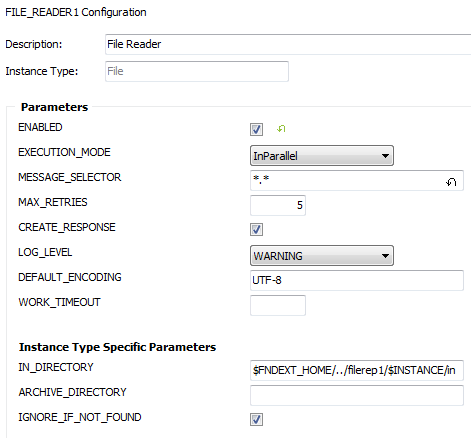Configure the File Transport Connector
The File transport connector makes it possible to send and receive files from
and to
IFS Applications.
The File Reader scans an IN directory for messages in any format and executes
them.
The File Sender has the ability to send files in different xml-formats or plain
text to an OUT directory.
Note: This page explains configuration based on default
instances FILE_SENDER1 and FILE_READER1, but there is no
difference in configuration of arbitrary File Reader or File Sender.
Note: If the user does not have write permission to create this folder structure in Unix environments, it should be created manually at the first time. After that the full
access rights to the normal user should be granted.
Contents

- WRITE_MODE
Defines if the sender can overwrite existing files or creates new
ones with unique ID in the file name.
- OUT_DIRECTORY
Root directory to which the sender writes files.
- WRITE_TO_DESTINATION
If ticked the file sender will write files directly to the folder specified
in OUT_DIRECTORY. Otherwise the sender will write files to a
temporary folder and when finished writing move the files to the folder
specified in OUT_DIRECTORY.
- CREATE_LOCK_FILE
If ticked and also WRITE_TO_DESTINATION is ticked, the file sender will create a file with the same name but ending
with .LOCK before starting to write a file. When the file is written the
lock
file is removed.
- TEMP_DIRECTORY
Temporary directory that is used if WRITE_TO_DESTINATION is not
ticked. If empty a temp subdirectory in OUT_DIRECTORY
will be used.
Additional parameters are specified on Routing Address for
Destination Type File.

- IN_DIRECTORY
Directory from which the reader is reading files.
- ARCHIVE_DIRECTORY
If specified, the reader will move the successfully processed files to this
directory rather then deleting them.
- IGNORE_IF_NOT_FOUND
If ticked, read retry of a file that no longer exists will be ignored. Such
situation can arise if the file has been removed or changed after it has
been listed but before it has been read. See also
file based reader
considerations. If un-ticked a read attempt of a file that not exists
will result in a failure leaving the corresponding entry in
Connect Reader Queue
with status Read Failed.
It's possible to create new instances of the File Reader Transport Connector
provided that they should scan distinct directories (Only one File Reader can
scan an in-directory).
Instructions for how to create a new connector instance.


